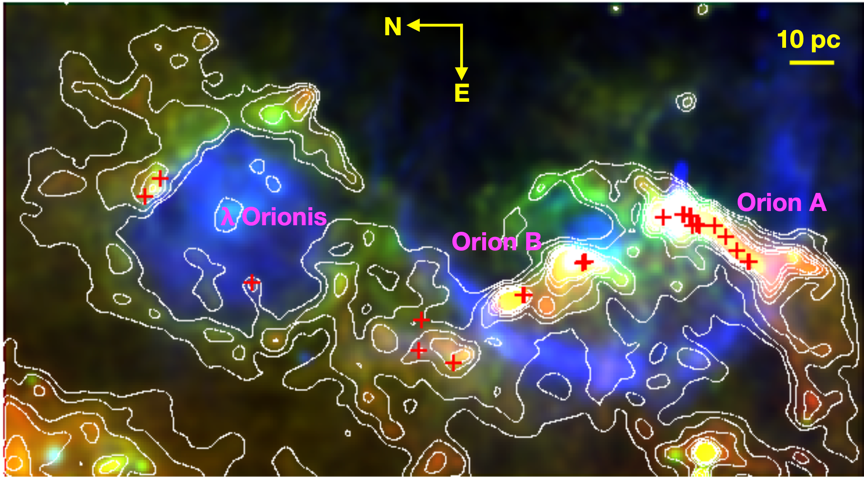Submilimeter Polarization and Astro-Chemistry in Earliest star formation
Stars form in the densest parts of molecular clouds, called prestellar cores. However, how prestellar cores form and collapse to form stars is far from being completely understood. In particular, the role of magnetic fields in the process of core formation and core collapse is unclear. Here we propose to the JCMT to conduct dust polarization and molecular line mappings toward a well-selected sample of ~65 densest cloud cores (in 24 fields) in the filamentary Orion Giant Molecular Cloud (GMC). Most of the targeted cores are at their earliest evolutionary stages (prestellar or Class 0). The JCMT polarization and molecular line data will be combined with ALMA data as well as data collected from other telescopes (e.g., SMA, SOFIA, NRO 45-m) to constrain the multi-scale polarization and chemical structures of those cores.
From the proposed observations, we aim: (1) to probe magnetic fields inside filaments and around dense cores. By comparing with state-of-the-art simulations, we will investigate how magnetic fields regulate core formation and guide accretion flows around the dense cores in filamentary clouds; (2) to investigate the gravitational stability of cores by considering all support mechanisms from thermal, turbulent, and magnetic pressures; (3) to investigate the grain alignment efficiency and dust grain properties in dense cores; (4) to pioneer cold cloud chemistry by 3D chemical modeling and constrain grain properties; (5) to study the correlations between protostellar outflows and magnetic fields and assess the impact of outflows to the measurements of magnetic fields in the filaments and cores.
This is the first attempt to systematically measure the magnetic field structure and chemistry of dense cores that are located in a GMC environment (with a similar distance of ~400 pc) and are at their earliest evolutionary stages. This will produce the first large homogeneous data set that allows long lasting joint analysis and modeling of the total emission, polarization, and chemistry to jointly constrain the 3D cloud/core geometry, core age, and dust properties.

Three color (Planck 857 GHz in red, IRAS 100 micron in green and Hα in blue) composite image of the Orion GMC. The contours show the Planck 857 GHz emission. The 24 targeted fields in the “SPACE” survey are marked with red crosses.
Regional Coordinators: Tie Liu (SHAO, China), Kee-Tae Kim (KASI, Korea), Sheng-Yuan Liu (ASIAA, Taiwan), Gary Fuller (The University of Manchester, U.K.), Ken Tatematsu (NAOJ, Japan), James Di Francesco (NRC, Canada)
Other Coordinators in the management team: Jinhua He (YNO, China), Naomi Hirano (ASIAA, Taiwan), Mark Thompson (University of Hertfordshire, U.K.), David Eden (LJMU, U.K.), Yuefang Wu (PKU, China), Di Li (NAOC, P. R. China), Ke Wang (PKU, China), I. Ristorcelli (Others), Mika Juvela (Others), Sungju Kang (KASI, Korea)
– JCMT project code: M20AL006



